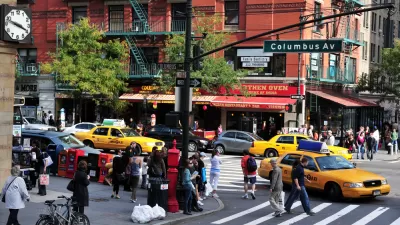"The Nation’s" longtime architecture critic and author of the classic, "Asphalt Nation: How the Automobile Took Over America and How We Can Take it Back" passed away Nov. 5. In her obituary, Preston Shiller contrasts her with another "Jane" - Jacobs.
Preston L. Schiller writes, "I was fortunate to have been acquainted with the two Janes beginning in the early 1990s and I benefitted greatly from talks and walks with each in their beloved neighborhoods. The two Janes met on at least one occasion and hit it off well, and Jacobs supplied a glowing blurb for the cover of 'Asphalt Nation'".
Schiller notes that Hotz-Kay was also influenced by Lewis Mumford, architectural critic for The New Yorker, "beginning with her 1960 Radcliffe senior thesis and first interview with him... I imagine a car-free corner and a café table where Mumford and the two Janes are seated—Holtz Kay between the other two to maintain the peace."
Jane Holtz Kay's obituary was published in The New York Times on Nov. 20 in the "Environment" section. Paul Vitello writes, "Her book ('Asphalt Nation'), subtitled “How the Automobile Took Over America and How We Can Take It Back,” proposed ways to reverse the environmental damage caused by suburban sprawl: by returning to the city, using public transit, living one’s daily life, as much as possible, within walking distance."
"Ellen Goodman, Ms. Kay’s sister and a former columnist for The Boston Globe, said Ms. Kay had grown up and raised her own children in the suburbs but decided to give up her car and move to an apartment in Boston when she began writing “Asphalt Nation” in 1991.
She died of complications of Alzheimer’s disease, Ms. Goodman said." She was 74.
FULL STORY: Remembering Jane Holtz Kay

Alabama: Trump Terminates Settlements for Black Communities Harmed By Raw Sewage
Trump deemed the landmark civil rights agreement “illegal DEI and environmental justice policy.”

Planetizen Federal Action Tracker
A weekly monitor of how Trump’s orders and actions are impacting planners and planning in America.

The 120 Year Old Tiny Home Villages That Sheltered San Francisco’s Earthquake Refugees
More than a century ago, San Francisco mobilized to house thousands of residents displaced by the 1906 earthquake. Could their strategy offer a model for the present?

In Both Crashes and Crime, Public Transportation is Far Safer than Driving
Contrary to popular assumptions, public transportation has far lower crash and crime rates than automobile travel. For safer communities, improve and encourage transit travel.

Report: Zoning Reforms Should Complement Nashville’s Ambitious Transit Plan
Without reform, restrictive zoning codes will limit the impact of the city’s planned transit expansion and could exclude some of the residents who depend on transit the most.

Judge Orders Release of Frozen IRA, IIJA Funding
The decision is a victory for environmental groups who charged that freezing funds for critical infrastructure and disaster response programs caused “real and irreparable harm” to communities.
Urban Design for Planners 1: Software Tools
This six-course series explores essential urban design concepts using open source software and equips planners with the tools they need to participate fully in the urban design process.
Planning for Universal Design
Learn the tools for implementing Universal Design in planning regulations.
Clanton & Associates, Inc.
Jessamine County Fiscal Court
Institute for Housing and Urban Development Studies (IHS)
City of Grandview
Harvard GSD Executive Education
Toledo-Lucas County Plan Commissions
Salt Lake City
NYU Wagner Graduate School of Public Service




























